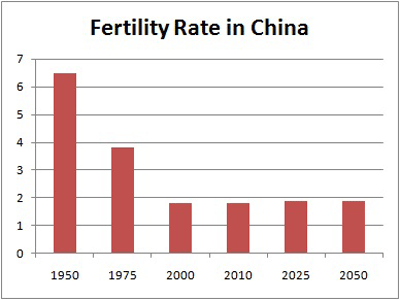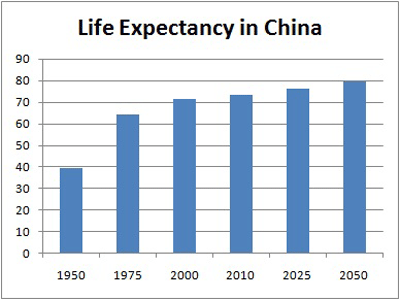




Asia's rapidly growing economies are grappling with populations that are also growing older at breathtaking speed.
And among those facing the onslaught of this worrying demographic deficit is China, whose red-hot growth rate in recent years transformed the world's most populous nation into the world's second largest economy.
Asia's economic success so far has been fueled by a "demographic dividend"—a jump in the rate of economic growth due to a rising share of working age people within the region's population.
But over the next four decades, the region's population will be aging on the back of declining birth rates and increasing life expectancy. The region will see families with few children, scarce workers, and rising number of senior citizens.
"Asia's population is aging at a speed unprecedented in human history," said Changyong Rhee, the chief economist of the Asian Development Bank, which warned this week that many economies in the region will be reeling from demographic turmoil.
"As the population dividend that fueled Asia's labor-intensive growth becomes a tax, the region must find more innovative ways to sustain its economic expansion, and to provide more comprehensive support for its growing elderly population," Rhee said.
As they confront the demographic challenge, countries in the region will face many of the same challenges now gripping developed economies—from rising old-age dependency burdens to graying workforces and declining savings and investment levels.
Significant rise
Many parts of East and Southeast Asia are already seeing a significant rise in the number of elderly.
In 2000, Japan was the only country with more than 15 percent of the population 65 years and older.
By 2050, most countries in East and Southeast Asia will have reached this level of population aging, including China and lower-income countries such as Indonesia, Burma and Vietnam, according to UN projections.
China will see the proportion of elderly to working age people quadruple between now and 2050. Within 25 years, it will be an older country than the United States.
China's fertility rate—the average number of children that a woman will have in her lifetime—has dropped to 1.8 and is expected to hover around that level over the next four decades, slashed half from 3.8 in 1975 and 6.5 in 1950.
Among the so called Asian "Tiger" economies, the rate has sunk far lower—to 1.3 in Singapore, 1.2 in South Korea, 1.1 in Taiwan, and 1.0 in Hong Kong.
With the elderly share of their population due to rise from 11 percent today to 24 percent in 2030 and 36 percent in 2050, the Tigers face a demographic future as daunting as that of any developed country.
But China will face a more formidable challenge even as it moves to relax its one-child policy.
Indeed, a policy change now that would result in birthrates rising sharply will not slow the aging trend for decades, studies show.
As fatter public budgets and higher tax rates are required to cope with a rapidly aging and developing China, experts worry not about the prospect of slower growth but the potential for a social and political crisis.
"China will face a massive age wave that could slow economic growth and precipitate political crisis just as it is overtaking the United States as the world's leading economic power [in the 2020's]," said Richard Jackson, who directs the Global Aging Initiative, a research program at the Washington-based Center for Strategic and International Studies (CSIS).
Principal pillars
By the 2020s, demographic trends may be weakening China's two principal pillars of the government’s political legitimacy: rapidly rising living standards and social stability, said a joint study by CSIS and global investment management firm Everest Capital.
Now holding more than three trillion dollars in foreign exchange reserves and running huge current account surpluses, China may also see a dip in its savings and investment levels amid the demographic shift.
In fact, the potential negative economic and social impact of East Asia’s age waves is beginning to alarm governments throughout the region and prompt eleventh-hour efforts to arrest the deteriorating demographics, the joint study said.
While the fiscal pressures of aging in most emerging markets will be less than in the developed world, the social stresses may be even greater, it said. Only a small fraction of the workforce in emerging economies is earning a benefit under any pension system, public or private.
The rapid growth of elderly populations in Asia may bring two important national goals into conflict, warn researchers tackling the demographic issue at the Hawaii-based East-West Center.
The first goal, they say, is to develop socioeconomic systems that will provide economic security to the growing number of old people and the other is to sustain strong economic growth.
"Achieving these two goals will require new policies, most importantly policies that encourage savings, investment in health and education to improve productivity, and well-functioning financial and labor markets," said researchers Andrew Mason and Sang Hyop Lee.
US unscathed
While most nations struggle to cope with population shifts, the United States is the only large country in the developed world that does not face a future of stunning relative demographic and economic decline, the CSIS report said.
"Thanks to its relatively high fertility rate and substantial net immigration, its current global population share will remain virtually unchanged in the coming decades. "
The United States was the third most populous country in the world in 1950, it is the third most populous today, and it will still be the third most populous in 2050, the report said.
"It is fashionable to observe that U.S. power has peaked," Jackson said. "Let's hope not, for demographic trends point toward a world that will need the United States more, not less."